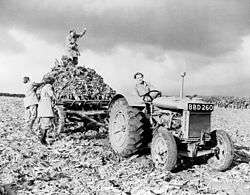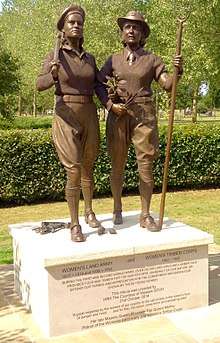Women's Land Army (World War II)
The Women's Land Army (WLA) was a British civilian organisation created during World War II so women could work in agriculture, reviving a disbanded World War One organisation and replacing men called up to the military. Women who worked for the WLA were commonly known as Land Girls. In effect the Land Army operated to place women with farms that needed workers, the farmers being their employers. They picked crops and did all the jobs that the men would do. Notable members include Joan Quennell, later a Member of Parliament.
- "Women's Land Army", "Land Girl" and "Land Girls" redirect here. For other uses, see Women's Land Army (disambiguation), The Land Girls (film) and Land Girls (TV series).

History
As the prospect of war became increasingly likely, the government wanted to increase the amount of food grown within Britain. In order to grow more food, more help was needed on the farms and so the government started the Women's Land Army in July 1939. Though under the Ministry of Agriculture and Fisheries, it was given an honorary head – Lady Denman. At first it asked for volunteers. This was supplemented by conscription, so that by 1944 it had over 80,000 members. The WLA lasted until its official disbandment on 21 October 1949.
The majority of the Land Girls already lived in the countryside but more than a third came from London and the industrial cities of the north of England. A separate branch was set up in 1942 for forestry industry work, officially known as the Women's Timber Corps and with its members colloquially known as "Lumber Jills" - this was disbanded in 1946.[1]
In popular culture
The Women's Land Army was the subject of:
- Angela Huth's book Land Girls (1995)
- A film loosely based on Huth's book, The Land Girls (1998)
- The ITV sitcom Backs to the Land (1977–78)
- The BBC dramatic series Land Girls (2009–11).
- The Powell and Pressburger 1944 film A Canterbury Tale features as the female lead a Land Girl, portrayed by Sheila Sim.
It also figured largely in:
- Series 3, Episode 3 (2004) of the ITV detective series Foyle's War, entitled "They Fought in the Fields".
- In the 2002 detective novel A Presumption of Death by Jill Paton Walsh, taking place in the early days of World War II, the plot centres on Harriet Vane and Lord Peter Wimsey trying to solve the murder of a land girl who had come to work at a village in Hertfordshire.
- The Play For Today episode Rainy Day Women.
Recognition

In December 2007, following campaigning by former Land Girl Hilda Gibson, the Department for Environment, Food and Rural Affairs (DEFRA) announced that the efforts of the Women's Land Army and the Women's Timber Corps would be formally recognised with the presentation of a specially designed commemorative badge to the surviving members. The badge of honour was awarded in July 2008 to over 45,000 former Land Girls.[2]
In October 2012, the Prince of Wales unveiled the first memorial to the WLA of both World Wars, on the Fochabers estate in Moray, Scotland. The sculpture was designed by Peter Naylor.[3] In October 2014, a memorial statue to the Women's Timber Corps and both incarnations of the Women's Land Army was unveiled at the National Memorial Arboretum in Staffordshire, England.[4]
See also
- Category:Women's Land Army members (World War II)
- Air Transport Auxiliary
- Australian Women's Land Army
- Home front during World War II
- Mechanised Transport Corps
- Rosie the Riveter
- Victory garden
- Women's Auxiliary Air Force
Further reading
- Bates, Martha. Snagging Turnips and Scaling Muck : The Women's Land Army in Westmorland Kendal Helm Press 2001 ISBN 0-9531836-9-6
- Kramer, Ann. Land Girls and their Impact, Remember When (2008), ISBN 978-1-84468-029-0.
- Rattray, Veronica. My Land Girl Years, Athena Press (2009), ISBN 978-1-84748-526-7.
- Twinch, Carol. Women on the Land: Their story during two world wars, Lutterworth Press (1990), ISBN 978-0-7188-2814-1.
- Tyrer, Nicola They Fought in the Fields: The Women's Land Army: The Story of a Forgotten Victory, Mandarin (1997), ISBN 0-7493-2056-7.
References
- Emma Vickers, "'The Forgotten Army of the Woods': The Women's Timber Corps during the Second World War" Agricultural History Review (2011) 59#1 101-112.
- "Women's Land Army". UK National Archives. Archived from the original on 23 January 2013.
- "The Prince of Wales unveils memorial to Women's Land Army". Prince of Wales. Retrieved 2 March 2017.
- "Memorial Arboretum Land Girls monument unveiled after three-year fundraising campaign". BBC News.
External links
| Wikimedia Commons has media related to British Women's Land Army. |
- Archives relating to the Women's Land Army
- Women's Land Army
- Spartacus Schoolnet WW2 Land Army
- BBC Information Page
- The story of the Women's Land Army in Leavenheath,Suffolk
- BBC Audio Slideshow about one woman's Land Army experiences
- Yorkshire Museum of Farming
- Women's Land Army collections Museum of English Rural Life